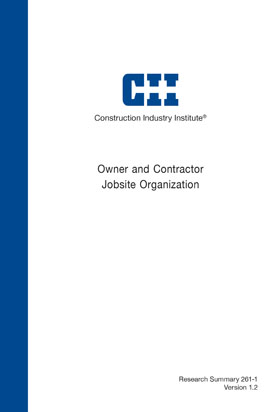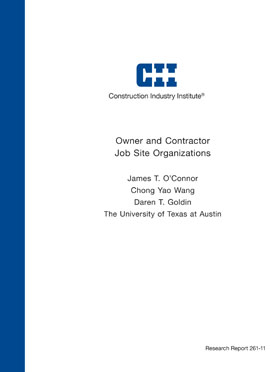
Owner and Contractor Jobsite Organization, Version 1.2
Over the past 30 years, jobsite management functions and their associated staffing levels have increased in number and complexity for both owners and contractors. This change has been in response to demands for greater levels of jobsite planning, resource management, and performance oversight. However, there is little published guidance or clarity on jobsite organization metrics or approaches. The primary purpose of this research was to identify and describe industry norms for jobsite organizational functions and staffing levels for owners and contractors, with special focus on finding the norms that provide the best value for different types of projects under different circumstances.
This is the first jobsite organization benchmarking study of its kind. The study targeted 31 industrial projects under construction over the last two years with total installed cost between $50 million and $800 million. The projects were examined in terms of jobsite organization parameters, project characteristics, execution parameters, and project success parameters. Benchmark metrics derived from this research pertain to owner and contractor jobsite organization size and constituent roles. The research team collected and analyzed data on organization size in terms of both staff full-time equivalent (FTE) and craft-to-staff ratio (CSR).
For the sample of projects examined, jobsite organization team sizes and CSR metrics vary significantly. These values range from three to 69 FTEs for owners, and from five to 143 FTEs for contractors. The mean craft-to-staff ratio for owner teams is 13.0 and 4.3 for contractor teams. From an FTE perspective, petrochemical projects have the largest owner teams, while construction-only projects have the smallest owner teams. EPC/design-build projects have the largest contractor teams, while construction-only projects have the smallest contractor teams.
High CSR values translate to smaller jobsite management teams. Power utility and construction-only projects have the largest owner CSR values, while cost reimbursable and EPC/design-build projects have the smallest owner CSR values. Lump sum projects have the largest contractor CSR values, while petrochemical, power utility, and EPC/design-build projects have the smallest contractor CSR values. CSR variability is quite large for owners, but much less so for contractors. Regression analyses indicate strongly correlated predictive equations for estimating contractor staff size (FTE) on the basis of either project capital cost or construction craft work hours.
The sampled projects suggest that there are six core jobsite organization roles with FTE > 1.0 for owners, and 16 such roles for contractors. Owner jobsite staffs are dominated by three management functions: quality, coordination, and commissioning. The predominant functions on contractor jobsite staffs are the following: field engineering, quality, materials management, safety, craft superintendents, procurement/supplier coordination, and area superintendents. Staff support for four contractor roles (a superintendent, craft superintendent, HSE management, and QA/QC management) are generally scalable or correlated with project size. Accordingly, mean craft-to-staff ratios have been provided for these individual roles.
Two-thirds of the owner projects examined outsourced jobsite staff functions, and this approach appears to be a growing trend. The amount of outsourcing for these projects ranged from 7 percent to 92 percent. Contractor project managers have a mixed opinion on their level of satisfaction with outsourced owner staff. Projects with larger owner and contractor jobsite staffs appear to be safer than projects with smaller staffs. Both owners and contractors should ensure that their management staffs are sufficient to promote worker safety.
Association trends have been analyzed for projects that perform better than average with smaller-than-average jobsite teams. Enabling factors appear to be the growth of trust between owner and contractor, higher quality of technical documents, and thoroughness of team role definition, change management, start-up planning, constructability planning, and front end planning, among others. Thus, there appear to be links between team effectiveness and implementation of CII Best Practices. Because it is widely believed that an organization's approach to jobsite organization can play a key role in project success—at a time when there is little tolerance for underperformance—it is important to better understand quantitative and qualitative dimensions of jobsite organization and their links to project performance.
From an FTE perspective, of the projects analyzed, petrochemical projects have the largest owner teams, while construction-only projects have the smallest owner teams. EPC/design-build projects have the largest contractor teams, while construction-only projects have the smallest contractor teams.
Additional observations on the variability of owner and contractor teams, based on FTE count and according to project characteristic are summarized in Table 3 and support the conventional wisdom with regard to the relative size of owner and contractor teams, based on a non-normalized FTE count. The exception is that owner teams for public projects are smaller than those for private projects.
Power utility and construction-only projects have the largest owner CSR values, while cost reimbursable and EPC/design-build projects have the smallest owner CSR values. Lump sum projects have the largest contractor CSR values, while petrochemical, power utility, and EPC/design-build projects have the smallest contractor CSR values. Lower CSR values indicate a larger staff size. CSR variability is quite large for owners, but much less so for contractors. Refer to Table 5 for CSR norms for subsets.
Six owner and 16 contractor roles dominate jobsite staffs (RS261-1, p. 14):
Owner core functions- Project Manager
- Coordinator/Supervisor
- Field Engineering Support
- HSE Management
- QA/QC Management
- Startup Management
- Project Manager
- Field Engineering
- QA/QC Management
- Refer to the publication for the others


